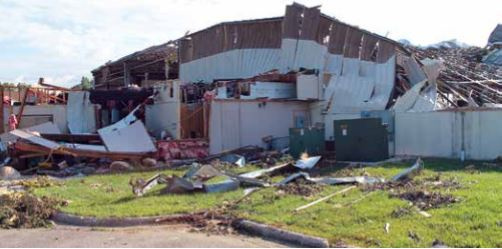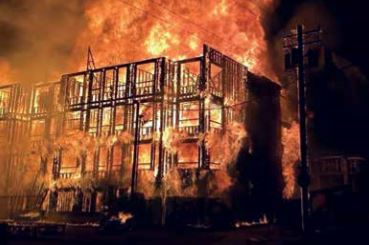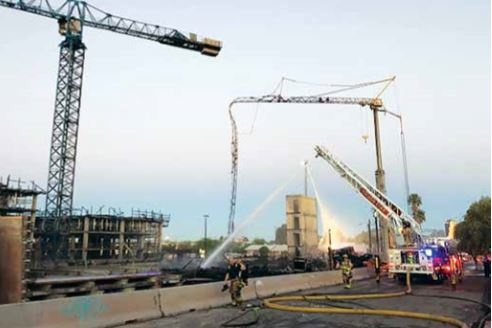Ensure You're Protected
Ensure You're Protected
Imagine your plant experiences a devastating catastrophe – a catastrophe that damages all of the equipment within it, large and small. Imagine that, once the dust settles and the reality of what just happened to you sinks in, you then allow yourself some slight relief from the thought that you have insurance. You should at least be able to recoup most of your losses.
Then, imagine your insurance company informs you that there are major gaps in your coverage for large pieces of equipment, and that the money you lost in the damage to your smaller tools would have been covered if you had purchased a certain kind of plan you didn’t previously know existed.
A similar situation of loss and disappointment did happen to Shem Jessop, owner of Agra Tech LLC, a framing company based in Cedar City, Utah. While not a component manufacturing plant, a devastating fire at one of his jobsites near the University of Arizona in Tucson, Arizona this summer destroyed a multifamily structure he had been working on. In addition to virtually leveling the incomplete wood framing, the fire destroyed his tower crane and his crew’s framing equipment.

Calamity can strike anyone, framers and CMs alike. CM Zeeland Lumber and Supply’s Wyoming, Michigan facility was destroyed by a tornado in 2015. Imagine this happened to you.
In the aftermath, the shock and devastation of the fire was exacerbated by some painful lessons Shem learned about the state of his insurance coverage at the time of the fire – lessons he hopes to share for the benefit of others so they can avoid the same pitfalls. Shem’s story is particularly instructive for owners of small to mid-sized companies without employees dedicated to monitoring insurance coverage. His experience helps demonstrate the importance of quarterly insurance reviews and provides some insight into what these reviews should include.
After the fire, Shem learned that though his destroyed tower crane was worth over $200,000 at the time of the fire, it was covered in his insurance policy for only $80,000 – the lien holder pay-off amount. Due to market demand, the value of Shem’s crane grew far above the $200,000 he had originally paid. In fact, this was something Shem actually noticed upon looking into his coverage months before the fire. Shem noted “several pieces of equipment [for which] we had some lack of coverage gaps,” he says, and the destroyed tower crane was one of those pieces. He discussed the gaps with his insurance agent and assumed the issue was settled; however, while his coverage was corrected for several of the pieces, coverage for the crane was not.
 First, Shem’s experience underscores the importance of, as he points out, “keeping track of market value,” and ensuring your coverage reflects the value of your equipment and lead times for finding a replacement. He reminds companies to “periodically check what your equipment goes for so that you can adjust up or down if you need to so you’re not over-insuring or under-insuring.”
First, Shem’s experience underscores the importance of, as he points out, “keeping track of market value,” and ensuring your coverage reflects the value of your equipment and lead times for finding a replacement. He reminds companies to “periodically check what your equipment goes for so that you can adjust up or down if you need to so you’re not over-insuring or under-insuring.”
Spending money on premiums for insurance that doesn’t appropriately cover what you have is, of course, less than helpful. To avoid mix-ups, it is prudent to send your agent/broker only the desired coverage amount of your equipment and avoid sending lien holder pay-off amounts, since this contributes to potential confusion. In addition, Shem advises that companies “check and double check” when it comes to correspondence with your insurance agent and any paperwork they return to you. A more thorough review of the insurance company’s adjustments based on Shem’s requests could have prevented a major loss in this case.
 In addition to a loss due to a gap in coverage, Shem also incurred a preventable loss from a lack of small tools and equipment coverage. Shem’s crew lost numerous uninsured hand tools in the fire, collectively amounting to an excess of $100,000 in value. While listing all of these items individually under a plan would have been tedious and unrealistically time-consuming, Shem learned that he could have insured these items under a small tools floater policy. Such a policy allows companies to insure tools worth $2,500 or less in aggregate for a specified overall value, eliminating the need to individually list and insure each tool. Exploring these options with your insurance agent can mitigate your risk while also saving an extraordinary amount of time.
In addition to a loss due to a gap in coverage, Shem also incurred a preventable loss from a lack of small tools and equipment coverage. Shem’s crew lost numerous uninsured hand tools in the fire, collectively amounting to an excess of $100,000 in value. While listing all of these items individually under a plan would have been tedious and unrealistically time-consuming, Shem learned that he could have insured these items under a small tools floater policy. Such a policy allows companies to insure tools worth $2,500 or less in aggregate for a specified overall value, eliminating the need to individually list and insure each tool. Exploring these options with your insurance agent can mitigate your risk while also saving an extraordinary amount of time.
In short, Shem’s advice is simple: Review your insurance policies at least quarterly to ensure coverage reflects the value of your equipment; communicate thoroughly and clearly with your insurance company about your needs, options, and any changes to your policy; and always check and double check the paperwork your agent sends after a change is made.
If he had to do things all over again, Shem says he would “have a date on my calendar” set aside for quarterly insurance reviews and conversations with his insurance agent. Even if no
coverage changes need to be made after a review, Shem still encourages that companies use that time to explore new options and discuss any business changes with their agents. “Get with your agent and make sure everybody’s on the same page,” he says.
Shem’s experience illustrates that catastrophe can strike even smaller companies who might least expect it. “We’re a small framer,” Shem says, and so he thought something like this would “never ever happen to a company our size.” However, the risk is there, and insurance is there to help prevent a major loss. It makes sense to ensure it will be there how you need it, when you need it.

